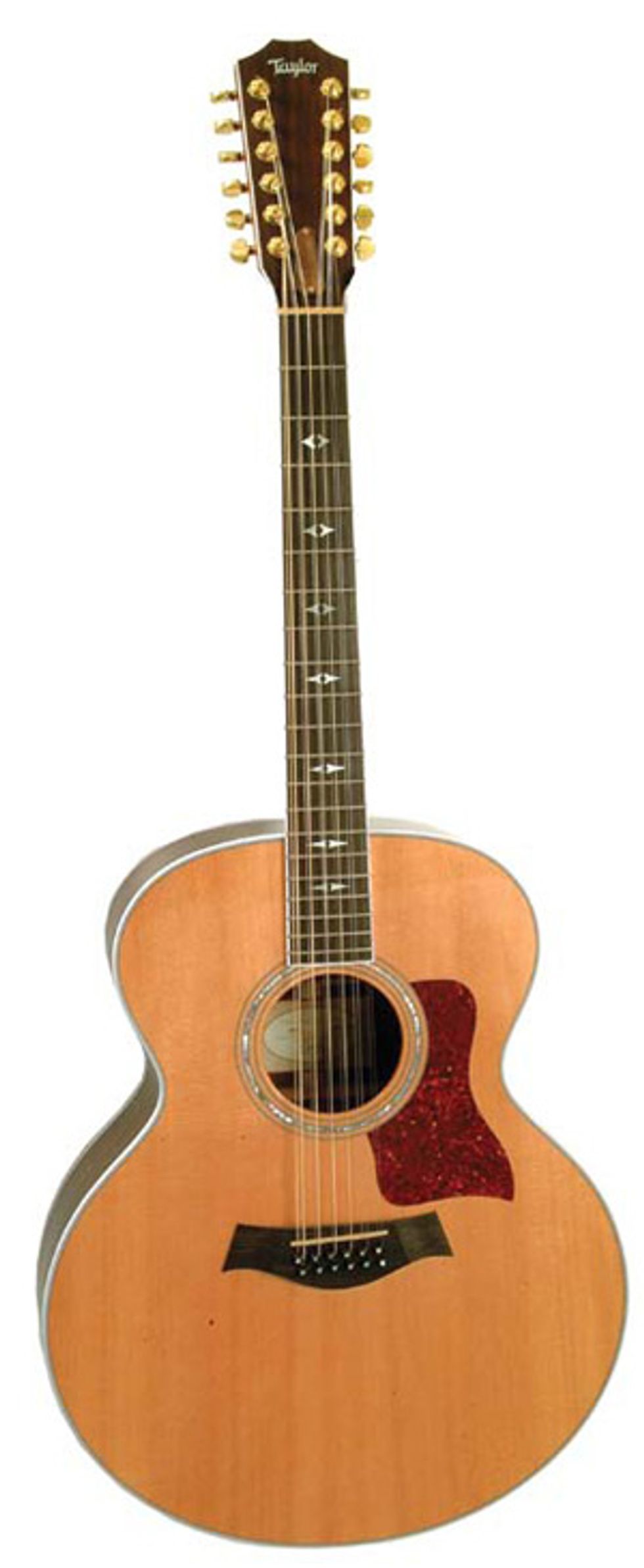Hey Zach,
I have a 2002 Taylor Model 855 (12-string) that I bought new, and I really enjoy playing it. I’ve noticed that Taylor no longer offers this model, and I’d like to find out exactly what woods were used when it was built. I’d also like to know what the guitar originally sold for and what it is worth today.
Thanks!
John in Columbus, Ohio
Hey John,
I’ve played the 855 and the thing booms like a cannon (in a good way!). I’m glad you inquired about this guitar, since Premier Guitar is focusing on “green guitars” this month, and Taylor is one of the industry leaders when it comes to responsible guitar building. Let’s take a look at Bob Taylor and Taylor Guitars, the 855 12-string, and how Taylor is practicing responsible guitar building today.
The history of Bob Taylor is truly a tale of innovation, patience, and success. It all started when Taylor decided to build guitars instead of attending college; he actually built three guitars before he graduated high school. In fact, the first guitar Taylor built in 1972 was a 12-string similar to an EKO Ranger 12-string. After graduation, Taylor went to work at the American Dream, which was a three-part guitar shop with a retail store, a workshop, and a repair center. In 1974, Taylor, along with fellow American Dream employees Kurt Listug and Steve Schemmer, bought the company and renamed it Westland Music Company. They also began branding their guitars “Taylor” in 1974. The rest of the 1970s was spent generating interest and establishing dealers for Taylor. By the 1980s, Taylor was well on its way and hasn’t looked back since.
Instead of branding their guitars with a “D” or “J” for dreadnought and jumbo, respectively, or using a cheesy model name, Taylor decided to use a numbering system that actually made sense. Guitar model numbers consisted of three digits. The first number indicated the type of wood and appointments, the second number indicated if it was a six-string (number under five) or a 12-string (number over five), and the third number stood for the body shape. The 800 Series was Taylor’s standard line in the 1970s, and the 700 and 900 Series followed shortly thereafter. Today, Taylor has an entire line of guitars ranging from 100 Series models all the way up to 900 Series models. The 855 featured a solid Sitka spruce top, solid Indian rosewood back and sides, an abalone soundhole rosette, tropical American mahogany neck, ebony fingerboard, gold-plated tuners, and an ebony bridge. The jumbo body shape is unique to Taylor, and although this guitar had been in production for several years, the body shape did change slightly in 2000. Taylor also made subtle changes over the years, but the general specifications have remained the same.
The 855 was discontinued in 2006, but the 855 Cutaway Electric is still in production. Taylor also introduced the Grand Symphony (GS) Series in 2006, which is similar to the jumbo body shape and includes a regular 12-string guitar. The 855 last retailed for $3558 and sold new in stores for around $2700. Today, used models in excellent condition bring between $2000 and $2300 in the used marketplace. I’ve also seen a picture of Neil Young playing an 855 in the 1970s!
Responsible guitar building is very important to many guitar manufacturers, and Taylor takes this issue very seriously. Granted, guitars take a lot less wood to build compared to lumber and furniture, but it is still the responsibility of the manufacturer to ensure there are trees available for years to come. Taylor doesn’t build specific “certified wood” guitars, but instead uses these woods in all of their guitars wherever applicable. For example, in 2001, Hurricane Iris ripped through Belize, leaving thousands of dead mahogany trees in its path of destruction. Years ago, these trees would be left for dead, but Taylor realizes the importance of using what is available and not necessarily convenient. By 2004, Taylor had harvested many of these trees for use as mahogany necks in their guitars. They also are adamant about replanting in place of what they harvest.
With Taylor’s combination of innovation and responsibility in guitar making, I see them having a bright future and your guitar being a treasure for many years to come. The bottom line when it comes to guitars is whether it plays well and sounds good, and Taylor nails both of those right on the head.
Sources: Taylor Guitars: 30 Years of a New American Classic, by Michael John Simmons and Taylor’s Wood & Steel Volume 41, Summer 2004.
Zachary R. Fjestad
Zachary is the author of the Blue Book of Acoustic Guitars, Blue Book of Electric Guitars, and the Blue Book of Guitar Amplifiers. Questions can be submitted to:
Blue Book Publications
Attn: Guitar Trash or Treasure
8009 34th Ave. S. Ste #175
Minneapolis, MN 55425
800-877-4867
bluebookinc.com
guitars@bluebookinc.com
I have a 2002 Taylor Model 855 (12-string) that I bought new, and I really enjoy playing it. I’ve noticed that Taylor no longer offers this model, and I’d like to find out exactly what woods were used when it was built. I’d also like to know what the guitar originally sold for and what it is worth today.
Thanks!
John in Columbus, Ohio
Hey John,
I’ve played the 855 and the thing booms like a cannon (in a good way!). I’m glad you inquired about this guitar, since Premier Guitar is focusing on “green guitars” this month, and Taylor is one of the industry leaders when it comes to responsible guitar building. Let’s take a look at Bob Taylor and Taylor Guitars, the 855 12-string, and how Taylor is practicing responsible guitar building today.
The history of Bob Taylor is truly a tale of innovation, patience, and success. It all started when Taylor decided to build guitars instead of attending college; he actually built three guitars before he graduated high school. In fact, the first guitar Taylor built in 1972 was a 12-string similar to an EKO Ranger 12-string. After graduation, Taylor went to work at the American Dream, which was a three-part guitar shop with a retail store, a workshop, and a repair center. In 1974, Taylor, along with fellow American Dream employees Kurt Listug and Steve Schemmer, bought the company and renamed it Westland Music Company. They also began branding their guitars “Taylor” in 1974. The rest of the 1970s was spent generating interest and establishing dealers for Taylor. By the 1980s, Taylor was well on its way and hasn’t looked back since.
Instead of branding their guitars with a “D” or “J” for dreadnought and jumbo, respectively, or using a cheesy model name, Taylor decided to use a numbering system that actually made sense. Guitar model numbers consisted of three digits. The first number indicated the type of wood and appointments, the second number indicated if it was a six-string (number under five) or a 12-string (number over five), and the third number stood for the body shape. The 800 Series was Taylor’s standard line in the 1970s, and the 700 and 900 Series followed shortly thereafter. Today, Taylor has an entire line of guitars ranging from 100 Series models all the way up to 900 Series models. The 855 featured a solid Sitka spruce top, solid Indian rosewood back and sides, an abalone soundhole rosette, tropical American mahogany neck, ebony fingerboard, gold-plated tuners, and an ebony bridge. The jumbo body shape is unique to Taylor, and although this guitar had been in production for several years, the body shape did change slightly in 2000. Taylor also made subtle changes over the years, but the general specifications have remained the same.
The 855 was discontinued in 2006, but the 855 Cutaway Electric is still in production. Taylor also introduced the Grand Symphony (GS) Series in 2006, which is similar to the jumbo body shape and includes a regular 12-string guitar. The 855 last retailed for $3558 and sold new in stores for around $2700. Today, used models in excellent condition bring between $2000 and $2300 in the used marketplace. I’ve also seen a picture of Neil Young playing an 855 in the 1970s!
Responsible guitar building is very important to many guitar manufacturers, and Taylor takes this issue very seriously. Granted, guitars take a lot less wood to build compared to lumber and furniture, but it is still the responsibility of the manufacturer to ensure there are trees available for years to come. Taylor doesn’t build specific “certified wood” guitars, but instead uses these woods in all of their guitars wherever applicable. For example, in 2001, Hurricane Iris ripped through Belize, leaving thousands of dead mahogany trees in its path of destruction. Years ago, these trees would be left for dead, but Taylor realizes the importance of using what is available and not necessarily convenient. By 2004, Taylor had harvested many of these trees for use as mahogany necks in their guitars. They also are adamant about replanting in place of what they harvest.
With Taylor’s combination of innovation and responsibility in guitar making, I see them having a bright future and your guitar being a treasure for many years to come. The bottom line when it comes to guitars is whether it plays well and sounds good, and Taylor nails both of those right on the head.
Sources: Taylor Guitars: 30 Years of a New American Classic, by Michael John Simmons and Taylor’s Wood & Steel Volume 41, Summer 2004.
Zachary R. Fjestad
Zachary is the author of the Blue Book of Acoustic Guitars, Blue Book of Electric Guitars, and the Blue Book of Guitar Amplifiers. Questions can be submitted to:
Blue Book Publications
Attn: Guitar Trash or Treasure
8009 34th Ave. S. Ste #175
Minneapolis, MN 55425
800-877-4867
bluebookinc.com
guitars@bluebookinc.com











![Rig Rundown: Russian Circles’ Mike Sullivan [2025]](https://www.premierguitar.com/media-library/youtube.jpg?id=62303631&width=1245&height=700&quality=70&coordinates=0%2C0%2C0%2C0)








